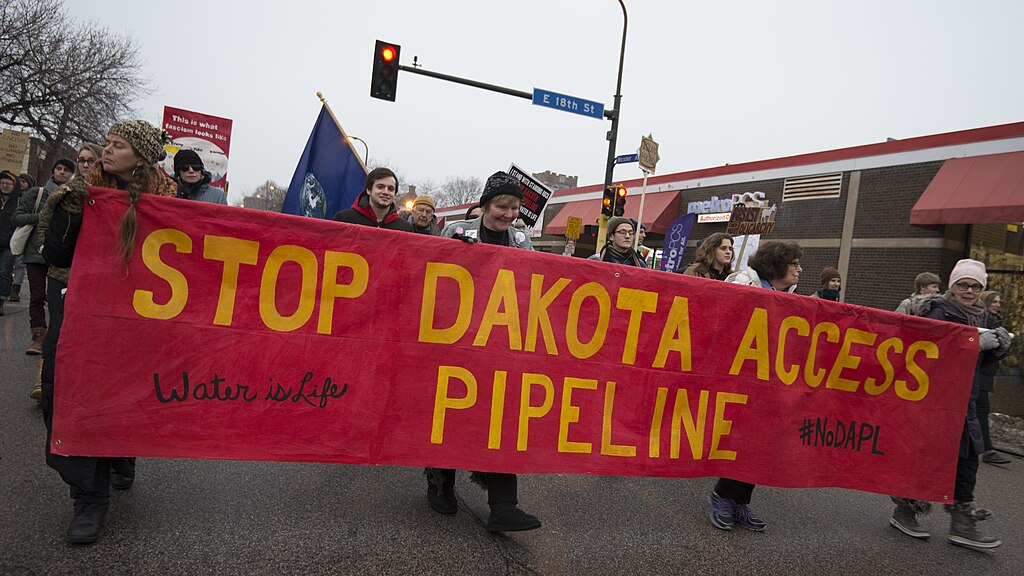SHA 2018 New Orleans
From the Newsletter of the Bulletin of the Archaeological Society of Connecticut, Winter 2018
Two weeks ago as I write this I chaired a session of the annual meeting of the Society for Historical Archaeology in New Orleans titled “The John Hollister Site: A 17th Century Fortified Farm Complex in Glastonbury, Connecticut.” The session was devoted to preliminary analysis of work conducted at the since 2015. This was a special chance to let archaeologists from across the country know about this important new site, as well as an important opportunity for graduate students and recent post graduates to present their research. For those unfamiliar with the John Hollister site, it is an expansive 17th century farm complex located beside the Connecticut River in South Glastonbury. The site has yielded extraordinarily rich information about this poorly documented period of English settlement in Connecticut.
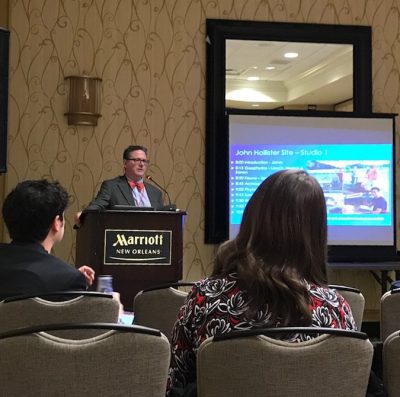 Introduction
Introduction
The two-hour session began with my own short introduction to the site. In the talk I summarized the history of English land ownership and associated probates, noted the history of archaeological work conducted to date and the overall layout of the farmstead, and presented images of some of the most interesting artifacts from the site. These include a variety of clay pipes, delftwares, slip-decorated wares, stoneware and glazed red earthenwares. Some of these ceramics have so far defied clear classification, and feedback from the audience has helped move our exploration of their origins in some new directions. I finished by noting the site’s significance to both Connecticut and the broader Atlantic seaboard’s understanding of this important phase of English (and Dutch) settlement in the region.
Remote Sensing
This was followed up by a talk by Peter Leach (UConn) coauthored by Maeve Herrick (University of Denver) and Jasmine Saxon (University of Denver) . Leach, Herrick and Saxon summarized the remote sensing work conducted in 2015 and 2016, including magnetometry and ground penetrating radar. The talk discussed the use of these methods not only for identifying subsoil features, such as the five cellars, two wells, many large pits and probable wigwam structures associated with the site, but also their use in better understanding the underlying geology of the site. They noted that the core area of settlement is located on a slightly higher moraine-like glacial landform bounded to the south and north by water-lain sediments filling relict channels. The paper was largely an encapsulation of Herrick’s recent Master’s Thesis from the University of Denver. One of her key findings was the presence of a fifth stone-lined cellar well south of the core habitation area, as well as three nearly adjacent probable Native American house floors. These appear in radar to be semi-subterranean wigwam-like oval structures, and limited testing conducted this summer established that at least the central feature is contemporaneous with the rest of the Hollister Farm settlement.
Faunal Analysis
Sarah Sportman (AHS, Inc.) then summarized her preliminary examination of faunal remains from the site. Questions that can be addressed through the analysis of the site’s animal bones include the following: 1) what can the faunal assemblage tell us about foodways and diet at the site? 2) what can it tell us about animal husbandry practices? 3) what do the faunal remains tell us about food procurement strategies? 4) what does the assemblage tell us about disposal patterns, site formation processes, and site abandonment? 5) what do the skeletal parts and butchery patterns tell us about food production, procurement, and consumption? and 6) how does the faunal assemblage compare to other known 17th century sites in southern New England? Sportman noted that only about 26% of the bone assemblage indicated weathering on the surface, suggesting that most of the bone was buried rapidly in the cellars. Surprisingly, deer bone made up almost 50% of the identified specimens, indicating the importance of venison in the diet. Bone representation of deer body parts further indicated on-site butchering. Other wild game included raccoon, muskrat, skunk, woodchuck, squirrel and weasel family, as well as a number of small rodents. Noted, but not included in the study, were the numerous shellfish and fin fish remains. Domestic animals, including pig, sheep/goat, and horse made up only 26% of the identified bone. Butchering of the horse and evidence for the focused extraction of marrow also suggested that little food went to waste. This pattern suggests to Sportman a frontier signature, where hunted game still dominated the foods eaten, as domestic animal stocks were still being developed.
Botanical Analysis
This was followed by William Farley’s (SCSU) summary of preliminary identification of botanical remains from the site. Farley posed the following research questions: 1) can we reconstruct the environment of the farmstead? 2) can we reconstruct the diet and daily behaviors of those living and working there? 3) does the botanical data say something about intercultural exchanges and entanglements in 17th century central Connecticut? He noted that the identified plants reflect a variety of open farmland weeds, with fewer forest weeds and just one species of wetland plant, suggesting that the farm complex was largely surrounded by open agricultural fields. Food remains were dominated by maize and hickory nut, indicating the importance of these indigenous plants to the diet. While some beans were also present, the next most common species by count was domestic cherry, followed by grape, wheat and hazelnut. Farley suggests that the plant food remains reflect a diverse diet that combined both indigenous and European food resources. The plant foods do not indicate a focused agrarian lifestyle, but rather a more complex, heterogeneous strategy combining traditional English and Native American crops and wild resources.
Phytolith Analysis
Krista Dotzel (UConn) then summarized her examination of plant phytolith remains from soil samples taken at the site. Phytoliths are microscopic silica bodies that lend structural support to many plants, especially those in the grass family. Dotzel was curious if a phytolith study might indicate the use of plant species not documented in the historical record, such as barley potentially used for local beer making. Phyoliths are hardy remains that have also been used to identify specific areas of plant processing as well as broader environmental information. Her finds indicated the presence of maize in three samples, and wheat in one. Other phytoliths present included sedge family and woody plants, but were not species-specific. Other interesting observations included a very high abundance of phytoliths preserved in a bottle base from which a soil sample was preserved, as well as the presence of abundant fire-altered husk remains (probably wheat) from the ashy lens at the base of the south cellar. Exactly why this burned husk residue ended up on the cellar floor is something of a mystery, but it probably occurred during use of the site.
The Tobacco Economy
Jasmine Saxon (University of Denver) then discussed the role of tobacco smoking and money during the 17th century occupation of the Hollister site. Her talk noted that the second half of the 17th century was one of abrupt economic changes. In particular, the price of tobacco reached a low point in about 1650, significantly affecting the colonial economy. In Virginia, local red clay pipe manufacture increased markedly, reaching a peak around 1680. After this period, the local production of clay pipes declines. She concluded that it was likely that the relatively abundant red clay pipes identified at the Hollister site fit into this general economic pattern during the second half of the 17th century; a time when English imports such as pipes and Virginia tobacco may have become increasingly difficult to obtain, leading to not only local pipe manufacture in Connecticut, but possibly tobacco farming for local consumption as well. Her finds appear to be substantiated by recent pXRF analysis conducted by UConn undergrad Caitlin Kingston suggesting many of the red clay pipes found at Hollister may be of local origin.
Wangunk Interaction
Maeve Herrick (University of Denver) then discussed her analysis of Native American pottery from the Hollister site as a material expression of interaction with the local Wangunk people. Her examination of the sherds indicate that these are best described as Shantok ware, a type defined originally at the Mohegan site of Fort Shantok in Uncasville, Connecticut. This style was manufactured by Native people across much of Connecticut between the Pequot War and King Philips War, that is, during the second and third quarters of the 17th century. The pottery typically includes two or four rim castellations, marked by molded figures or geometric patterns possibly representing the corn maiden motif, common to Iroquoian pottery of the same period. It is often decorated with attached medallions, protrusions typically decorated with an incised slit motif, above which typically occurs obliquely incised striations. This description is an excellent fit to the ca. 300 sherds of pottery recovered from the cellar fill at the Hollister site. The presence of these large sherds with other English material culture remains indicates that the Hollister family possessed more than one locally manufactured Native American pottery vessel, and that these were eventually discarded with other debris into the abandoned cellar holes at the site. Herrick also pointed to her GPR work indicating a probable area of Native American habitation at the south end of the site, further indicating that a complex relationship existed between the Hollisters and one or more Wangunk families who possibly resided very near the core settlement area of the farm for a number of generations.
Material and Identity
Megan Willison (UConn) finished the session with a talk titled “Identifying Status and Identity through Material Remains.” Willison’s core research questions were: 1) how can status and identity be inferred from artifacts? 2) how do artifact groupings inform archaeologists about life in the past? and 3) how does this information bolster written or oral accounts of the inhabitants of the Hollister site? Willison summarized theoretical concerns including the cultural biography of objects, issues of materiality and identity, and the concept of cultural entanglement theory. Cultural entanglement theory is fast supplanting older concepts of acculturation that tended to deemphasize the active role of Native American people and their culture during the colonial period. Cultural entanglement theory promotes a discussion of power relationships and cultural fluidity between groups – especially during periods such as the 17th century when Native Americans outnumbered the English and the ultimate outcome of the colonial enterprise was not yet clear. Willison noted the presence of both Native American pottery on the one hand and window glass and examples of high-status ceramics such as the north Italian marbleized slipware to discuss the complex expressions of materiality and identity at the Hollister site situated at both the physical and cultural frontiers of Native American and English society.
To conclude I just want to express how proud I was of all of the session participants for their hard work and excellent presentations. First, I’d like to thank Fiona Jones for managing the projector which kept the talks running smoothly. I also want to be sure to thank Mark Packard and his family for permitting us to continue work at this extremely important and increasingly remarkable site. I would also be remiss not to mention the support of the Historical Society of Glastonbury, in particular Jim Bennett and Diane Hoover who have actively promoted work at the site. Finally, this session would not have been possible without the financial support of Mr. Bob Hollister, a Hollister family descendant who very graciously provided funding that supported the research behind many of the talks presented at this session.
News from the Office of State Archaeology
New OSA lab
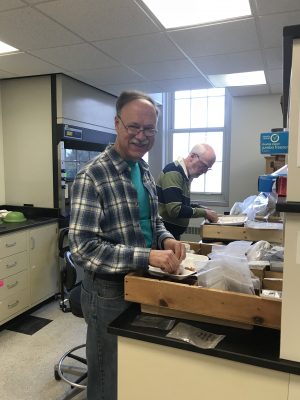
Lee and Dick prepping artifacts in the new lab in Beach Hall.
Data entry
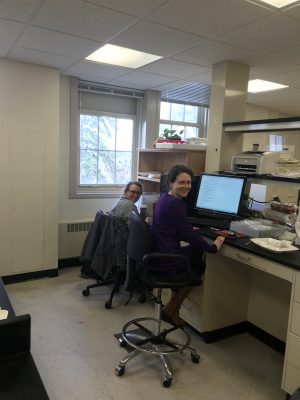
Lab RA Brianna Rae and senior Caitlin Kingston working in the new lab.
FOSA Newsletter, Fall 2017
UConn is back in session and there have been a number of very recent and exciting changes for the Office of State Archaeology. I have been assigned a new office in Beach Hall, and people can now find me in Beach 301 just down the hall from Kevin McBride’s New World Archaeology lab and across from Dan Adler’s Old World Paleolithic lab. It’s nice to finally be back in familiar company and out of the Math Department. In addition to the office, I have at least temporary use of the adjacent lab in Beach 305. As I write this, I’m still waiting for final permission to set up shop, but the new lab space is a huge step forward for OSA. There are six bench top areas and work stations, two sinks, a fume hood, and plenty of other table space and shelving. My goal is to get all of the summer’s archaeological materials moved there and get to work on artifact washing and inventory work as soon as possible. The CT State Site files are already in my office, and soon I hope to get all of the CRM reports located there as well so that all of the records are finally joined in one location for those who need to do background research for projects. Anthropology has requested space for a map and records room and even a field equipment room in addition to the office and lab space for OSA. These additional spaces have not yet come into discussion, but I’m keeping my fingers crossed since there is plenty of new space available now that molecular and cell biology has moved to a new building. Once we are ready to start the move from Horsebarn Hill Building 5, I’ll let folks know. There will be plenty of opportunity to help out soon!
This was also a busy summer for OSA and FOSA volunteers. We first helped Ingrid Wood, Columbia’s Town Historian by exploring foundation ruins thought to be associated with the Little family, some of the town’s earliest settlers. Ingrid organized a terrific public outreach dig focused on a sixth grade audience, as well as a number of local teachers. It was a pleasure to work with her and the kids, and a big thanks to all who were able to help out.
The Connecticut State Museum of Natural History and OSA ran their second Archaeology Field School for Educators. This year the program grew and we had a great bunch of participants, some of whom would like to run archaeology programs of their own now that they have some experience. This year we followed up on Robert Gradie’s 1990 and 1991 investigations of the Oliver Ellsworth National Historic Landmark homestead. We were successful at locating a large 17th Century cellar feature (with the help of Debbie Surabian’s radar) and we have an excellent sample of artifacts to examine this winter. A number of FOSA members were able to act as mentors during the program, and special thanks go out to Lori Kessel, Mike Cahill, Scott Brady and Fiona Jones. Jim Trocchi, Lee West and Dick Hughes also helped during week two, our public drop-in week. The award for hardest working volunteer has to go to Dick, who single handedly completed most of the backfilling of our deep excavation areas on the final day – what a guy!
August was our chance to get back to the John Hollister site. This year’s Connecticut State Museum of Natural History Adult Archaeology Field School filled up, so there was plenty of opportunity for FOSA volunteer mentoring. During the week of field school we looked for features that might help us to interpret the architecture of the site. In addition to some 20th Century tobacco shed footings, we did document about a dozen other large pit features that may be associated with framing timbers from an earth-fast house at the site.
The second week at the John Hollister site was our third annual FOSA Field School, and we had a great turnout, including some new members from the earlier summer field schools. That week we focused on the new fifth cellar and one of the three possible wigwam features near it. Both features produced artifacts contemporary with the core residential area of the site. While it remains unclear if this is actually the occupation are of one or more Wangunk families that might have worked for the Hollisters, we did find two wampum beads and a very interesting, possibly French made pipe that probably had its origins at Fort Pentagoet about 350 miles to the northeast in Maine’s Penobscot Bay. The French military outpost of Pentagoet has produced the largest number of these pipes and they do not yet appear to have been documented in southern New England or New York. Speculating how this King Philips War-era pipe got to Glastonbury is likely to keep us preoccupied for a while.
In sum, it was a busy summer and we have lots of lab work ahead of us. Keep your ears open regarding lab work opportunities in Beach Hall soon. It is hard to express how satisfied and grateful I am to have a clean, modern lab space made available. I think it is a sign of good things to come!
News from the Office of State Archaeology

ASC Newsletter, Summer 2017
I just enjoyed a terrific visit from Dr. Emerson “Tad” Baker who came down from Salem State University to present a paper at the most recent Friends of the Office of State Archaeology annual lecture. Tad is an expert on 17th century New England material culture and architecture, so it was a treat to have him up at the UConn archaeology lab to look over artifacts found last summer at the Lt. John Hollister site. We both agreed that there is a lot to learn about this period in New England both north and south of the Puritan-dominated Massachusetts Bay and Plymouth colonies. Both southern Maine and Connecticut appear to be producing sites established by sometimes wealthy landholders with close ties to the English West Country, the area encompassing modern Devon, Cornwall, Wiltshire, Somerset, Dorset, and Gloucestershire in southwestern England. It appears that many individuals arriving in the New England colonies in the 1630s and 1640s from this region brought their own building traditions and dreams of establishing wealthy estates. The longhouse and cross-passage style houses now being identified here in Connecticut and Maine have direct ties to West Country building traditions and are quite different from the better documented Hall and Parlor type houses we are more familiar with.
This summer’s schedule is being hammered out as I write this, but a few dates are worth noting now. First, the one-week Archaeology Field School for Educators will run Monday, July 10 through Friday, July 14, 9 am to 3 pm. The field school is sponsored by the Connecticut State Museum of Natural History at UConn and Office of State Archaeology. This field school is designed to give educators who teach history or social science in a classroom or museum setting a deeper appreciation of the importance of archaeology as a tool for learning about Connecticut’s fascinating past. Participants will experience an authentic and significant archaeological investigation, working with primary sources at a historic site in Windsor. If all goes as planned, we will be examining the 17th century history of the Oliver Ellsworth lot. Participants will also learn about the role of the Connecticut Office of State Archaeology and how it can be an important resource in developing archeological lessons and activities for students. Space is limited. To request a registration form please contact David Colberg at david.colberg@uconn.edu or 860.486.5690.
Connecticut State Museum of Natural History at UConn and Office of State Archaeology will conduct its Adult Field School for the general public Monday, July 31st through Friday, August 4th. The current plan is to revisit the 17th century Lt. John Hollister site in South Glastonbury. Our primary goal this summer will be to expose evidence relating to the architectural layout of the site. Further information should be available soon at the CSMNH calendar page: http://www.cac.uconn.edu/mnhcurrentcalendar.html. Space will be limited. To register please contact David Colberg at david.colberg@uconn.edu or 860.486.5690.
Finally, members of the Friends of the Office of State Archaeology will be able to continue work at the Hollister Site from August 7th-11th. If you are not yet a FOSA member, go to http://www.fosa-ct.org for more information.
News from the Office of State Archaeology
GPR at Webb-Dean-Stevens
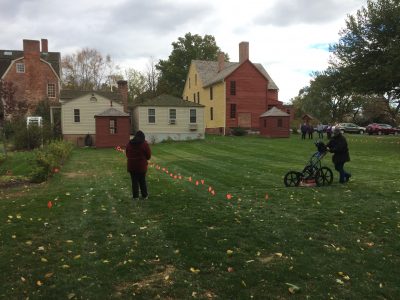
Spring 2017 News From the Office of State Archaeology
It has been a time of change here on campus for the Connecticut State Museum of Natural History. Many of you may have heard that the museum lost the exhibit and office space it has held for the past decade. Officially, staff has been shifted from the College of Liberal Arts and Science to the Office of Public Engagement, yet the museum maintains a strong degree of autonomy since state statutes very wisely provide direct oversight by the museum’s board of directors, rather than a single university division. Nonetheless, it has been a time of significant challenges for director Leanne Harty, program coordinator David Colberg, exhibit developer Colin Harty and myself. One of the positive things to come from the move is a recently drafted strategic plan written to guide museum priorities over its next three years. One of those priorities is the return of permanent exhibit space, since without it, we are ineligible for many federal funding opportunities. Coordination with Public Engagement also has the potential to provide a new impetus for programming and outreach activities, and I am currently developing a number of potential project ideas for the coming summer. For those looking for me, I am temporarily housed with Math Department faculty in Monteith 408.
I just made a list of over twenty important activities that occurred last fall and early winter, but I’ll stick to a summary of just a few. First, I’d like to thank FOSA President Mandy Ranslow, and members Nick Bellantoni and Gary Nolf for their help running four hands-on programs for kids held at Wood Memorial Library and Museum in South Windsor. OSA now has a thoughtfully packed box of educational materials that make programs like this focused on Native American and Colonial archaeology and history fun for young audiences. Hopefully we’ll further develop our core of educational volunteers for future programming opportunities.
FOSA members also had a chance to participate in Ruth Shapleigh-Brown’s and Debbie Surabian’s GPR survey demonstration at the Old Hebron Cemetery. Afterwards, a number of volunteers went on to help with some additional radar work at the Webb-Deane-Stevens House in Old Wethersfield. That work identified a number of large buried features, and I’m looking forward to hearing what they turn out to be (hopefully at least one buried cellar!) when AHS, Inc. gets back to investigate them this Spring.
Of course, October fifteenth was International Archaeology Day and this year we celebrated with the Connecticut Archaeology Fair at UConn, Storrs. Participation was great, with lots of booths, demonstrations and activities for kids, so my thanks go to all who helped to coordinate the event. Special thanks go to FOSA’s Mandy Ranslow and UConn Department of Anthropology’s Daniel Adler. Dan, in particular, managed to rustle up a lot of student support that made the day possible. FOSA’s own booth included a new book sale made up of material culled from the OSA library. These books were made available primarily because they were not directly associated with regional archaeology. Visitor’s purchased a number of interesting books with all funds donated to FOSA. The meeting also hosted the Archaeology Society of Connecticut’s fall meeting and included a variety of excellent talks, including one by Zac Singer summarizing last summer’s important work at the Templeton Paleoindian Site that many FOSA members helped with.
In the meantime, FOSA volunteers have been busy prepping and inventorying artifacts from the David Humphreys site (Ansonia) and I am pleased to say Scott Brady and Lee West just completed the data entry work on that interesting assemblage. FOSA volunteers also had a chance to organize a large donated collection from Nicholas Kotula. Nicholas’s artifacts came from a variety of sites across New England, New York and Pennsylvania. We have most recently been focused on organizing finds from the 1990 and 1991 UConn field schools at the Oliver Ellsworth House in Windsor because I have hopes of doing follow-up work there this summer. So, volunteers will still have plenty of opportunities to help this Spring in the lab. On campus, inventory work on the Lt. John Hollister site has progressed rapidly as well with the help of my research assistant Megan Willison and five undergraduate interns.
To wrap up, I just want to add how excited I am to have Emerson (Tad) Baker coming to speak to us on March 25 at Farmington High School. Tad has excavated a number of very significant 17th century settlement period sites in southern Maine, and is arguably New England’s expert on the material culture and architecture of this poorly documented period. Having him visit will provide an important opportunity to show him our own artifacts from the Lt. John Hollister site and discuss the potential architectural layout of that site based on the results of two season of radar examination. In that vein, be sure to sign up for the Connecticut State Museum of Natural History’s upcoming day trip to Plimoth Plantation scheduled for April 15th. I plan to use part of our time on the bus to discuss our recent finds at the Lt. John Hollister site as well as other important 17th Century topics.
News from the Office of State Archaeology
Historic Preservation and the Law: The Dakota Access Pipeline and the UConn Faculty Row Cases
It has been an interesting, if disconcerting, Fall regarding historic preservation and the law. In North Dakota, Army Corps of Engineers’ arguable mismanagement of the Section 106 process under the National Historic Preservation Act led to what was arguably the largest Native American protest in history. Much of the controversy over the Dakota Access failure ultimately boils down to five issues in my opinion. First is the Army Corps strict interpretation of its regulatory jurisdiction, which is in most cases limited to areas proximal to water crossings, rather than accepting the entire area of the undertaking as part of the Area of Potential Affect. Second is the limitation of NHPA regulations on private property – which made up much of the pipeline corridor in this case. Third, while one might expect that National Environmental Policy Act regulations would apply to a massive federally-permitted project such as this, it turns out that the most reasonable lead agency, the Federal Energy Regulatory Commission apparently has no regulatory authority over oil pipelines, though it does over gas pipelines. Fourth, tribal individuals and other critics have argued that standard archaeological surveys are not effective at identifying Traditional Cultural Properties because of a lack of cultural knowledge by most archaeologist. Finally, while the Army Corps says that they met tribal consultation requirements (a claim supported by a September court ruling), some Native American communities appear to have refused consultation, claiming that the Army Corps had not appropriately defined the full scope of project impact. Clearly something with the consultation process broke down, or the protest would not have exploded the way it did.
In short, the areas that fell under Section 106 review were largely limited to public lands at water crossings. In these areas, archaeologists completed surveys and identified 149 potentially National Register eligible sites, 140 of which were avoided (most of these were actually stone structure features that could be considered Traditional Cultural Properties). The remaining nine sites were to be mitigated in cooperation with the State Historic Preservation Office. However, much of the most contentious controversy over impacts to potentially sacred sites occurred on areas of private property that did not fall under the federal review process as it currently functions. Under White House pressure, the U.S. Army Corps of Engineers eventually denied the easement for the oil pipeline to cross under Lake Oahe, a Corps-managed reservoir on the Missouri River – something many tribes and other concerned citizens had been requesting for months. The future of that reversal is very much up in the air as we approach the new Trump administration.
Close to home, UConn has finally agreed to spare two of the nine faculty Row Houses during construction of a new recreation facility and campus redevelopment project. The State Historic Preservation Office (SHPO) has also asked that OSA conduct some archaeological investigations of the houses to better document their changing use throughout the 20th century. The nine houses were listed on the National Register of Historic Places in 1982 when they were also under threat of demolition, and every few years, that threat would be raised again. The most recent proposal resulted in a long-term negotiation between UConn and the SHPO. Actions by state agencies (and UConn is effectively a state agency in this case) are assessed under the regulations described in the Connecticut Environmental Policy Act (CEPA). CEPA is the state’s corollary to the National Environmental Policy Act (NEPA) and creates a framework to evaluate state-level project effects on the natural and cultural environment.
Meeting CEPA obligations simply means that the acting agency must “identify and evaluate the impacts of proposed State actions” to cultural and historic resources. In this case, UConn argued that preservation of the buildings was an unreasonable burden, primarily because of the costs of bringing these buildings up to code, but also because they were in the way of the new planned open space and recreation center and could not easily be avoided. In short, the resources were “identified and evaluated,” but their preservation was not considered feasible. SHPO issued a letter of adverse effect and requested mitigation to compensate for the historic loss. So, CEPA requirements were met through this process of evaluation and recommended compensation. Many members of the public were upset that another “CEPA,” the Connecticut Environmental Protection Act, could not be applied. The Environmental Protection Act includes language that gives the Historic Preservation Council (on which I sit) legal authority to invoke a “stay of demolition” for projects that do not fall under state environmental review regulations – typically for private undertakings on private lands that result in the unreasonable demolition of historic structures. In this case, initiation and completion of the Environmental Policy Act meant that action under the Environmental Protection Act simply did not apply.
Much of the negotiation between the SHPO and UConn during the past year was therefore focused on mitigation measures. These mitigation efforts included additional documentation of the houses, greater historic preservation efforts included in future campus development, and for UConn to provide a venue for a state-wide symposium on best practice in preservation for municipal leaders in the spring of 2017. This Fall, the state Office of Policy and Management also determined that the houses could not be demolished until mitigation was completed – effectively delaying demolition for a number of months. Further negotiations have resulted in the preservation of two of the buildings and continued commitment from UConn to adopt an enhanced review process for projects impacting historic properties in the future. As noted at the beginning, SHPO also contacted me about the possibility of running some archaeological programs on the faculty row houses that will be preserved. This programming would include shovel test pit excavations by students, and hopefully the public, to document the changing use of these buildings through their history. I’ll be sure t get the word out when that work gets scheduled, so pay attention to the Office of State Archaeology Facebook page in the coming months.
Recent Investigation of the 17th Century Lt. John Hollister Site, Glastonbury, Connecticut
Mag Data Collection
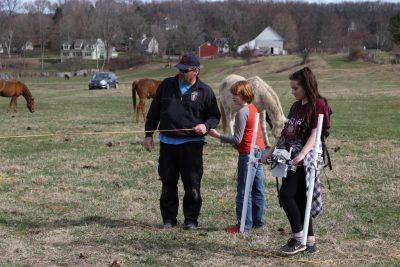
Jasmine Saxon collects magnetometry data at the Hollister Site, Glastonbury
pipe stems
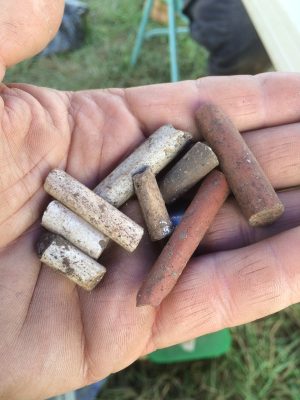
A variety of pipe stems from the 2016 Hollister Site excavation.
Middle Cellar 2016
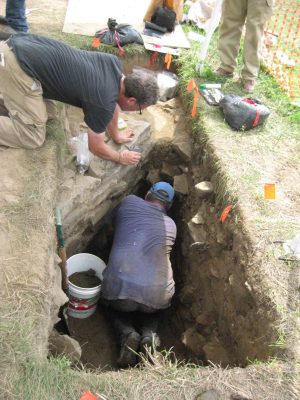
Excavation of the Middle Cellar in 2016
Conference on New England Historical Archaeology Newsletter, Fall 2016
Lieutenant John Hollister arrived at the young settlement of Wethersfield Connecticut from a village near Bristol, England in 1642. He married Johanna Treat (daughter of Richard Treat, a man of high social standing in the community), the same year and was admitted freeman in 1643. Preliminary genealogical research suggests that Hollister was a second son, thus unable to inherit his father’s estate in England. However, he appears to have arrived in New England with ample capitol, and according to Wethersfield land records, by 1655 had acquired twenty-three parcels of land totaling about 240 acres. Sixty acres of this land included a working farm located at Nayaug, on the east side of the Connecticut River. This farm was likely purchased prior to 1650 and included a house and outbuildings. Hollister’s growing family already occupied a home in Wethersfield center, and records indicate that he let out the farm to the Gilberts (another West Country family) in 1651. The Gilberts worked the farm for Hollister until 1663. Josiah Gilbert’s family included six children born during their occupancy, and his father and some of his brothers likely lived there as well.
Lieutenant Hollister died at a relatively young age in 1665. His lengthy probate lists assets valued in excess of £1600. His son John received “his house and barn, orchard and pasture” with “sixty acres of plowing and mowing with other land” in Nayaug, with the understanding that he would provide his mother with twenty bushels of apples and two barrels of cider a year. The probate also indicates that large quantities of both wheat (20 acres) and Indian corn (23 acres) were being grown on the farm. John married in 1667 and started his own large family at Nayaug. The farm was fortified with a palisade in 1675 to protect neighboring families and their farm products during King Philips War. During this time, John also aided the local Wangunk tribe with the construction of a palisade on high ground just north of Nayaug. Toward the end of his life, John parceled off his lands to his sons who began to raise their own families nearby. John Hollister died in 1711 and the house is believed to have fallen out of use by ca. 1715.
In 2015, the Glastonbury Historical Society and landowner Mark Packard, a Hollister descendent, approached the Connecticut Office of State Archaeology to run a public excavation in the large horse pasture believed to be the location of the John Hollister farm. In preparation for this, I asked UConn graduate student and ground penetrating radar expert Peter Leach to survey the area for features that might be worth investigating. That preliminary survey produced remarkable results – three large rectangular cellars were identified, as well as other probable outbuilding cellar features and a number of large pits or posts. The one-day Historical Society dig produced a small assemblage of artifacts that hinted that this could be the location of the Hollister farm, so a more intensive follow-up study was scheduled for 2016.
The 2016 field season began with a magnetometry study of about three acres of the pasture surrounding the core site area. This work was conducted by graduate students Maeve Herrick and Jasmine Saxon from the University of Denver. Herrick and Saxon followed this study with additional GPR work in July and August, expanding on Leach’s original survey. Archaeological excavations were undertaken in August through public programs associated with the Connecticut State Museum of Natural History (UConn) and the Historical Society of Glastonbury. The excavation season focused primarily on the three main cellar features identified in the radar surveys. Portions of these cellars were excavated to their floors at a depth of about 150cm. The cellar fill, passed through 1/8-inch hardware cloth, proved to have preserved very rich deposits of faunal remains, including both wild and domestic mammals, as well as turtle and fish bone, scales and abundant shellfish. Carbonized maize and bean were also identified during the excavation, and smaller botanical remains will likely be recovered from flotation samples.
Artifacts have yet to be inventoried, but included a large fragment of a north Italian marbleized slipware bowl, decorated and plain delftware sherds from both hollow and flat wares, abundant red and white clay pipe fragments (typically with 8/64-inch diameter stems), glass beads, a brass bell, a latten slip top spoon, rhenish stoneware and a variety of English slip-decorated and lead-glazed earthenwares, including probable examples of Midlands blackware and yellow borderware. Of particular significance was the recovery of fragments of a very large Native-made storage vessel near the bottom of the central cellar. This item is a tangible reflection of the close relationship between the Hollister family and the local Wangunk people.
The site is arguably one of the state’s most significant because of its age, richness, and lack of subsequent disturbance. In terms of material culture, it is perhaps most comparable to the Governor Sir William Phips Homestead in Woolwich, Maine examined by Robert Bradley. Architecturally, the Hollister residence may prove to reflect a very long West Country style “cross-passage” house, but further work will be required to determine if the three aligned cellars formed part of a single household structure or not. The site’s mix of wild and domestic food remains as well as the use of Native made pottery also bring to mind Sylvester Manor at Shelter Island, Long Island investigated by Stephen Mrozowski. Both of these sites represent similarly wealthy plantations and trade centers associated with important colonial families.
Analysis of the materials recovered from the site is just being organized now. A special session at the Society for Historical Archaeology conference is already being planned to present the results of that analysis in 2018, so stay tuned.
News from the Office of State Archaeology
The 2016 Templeton Site Crew
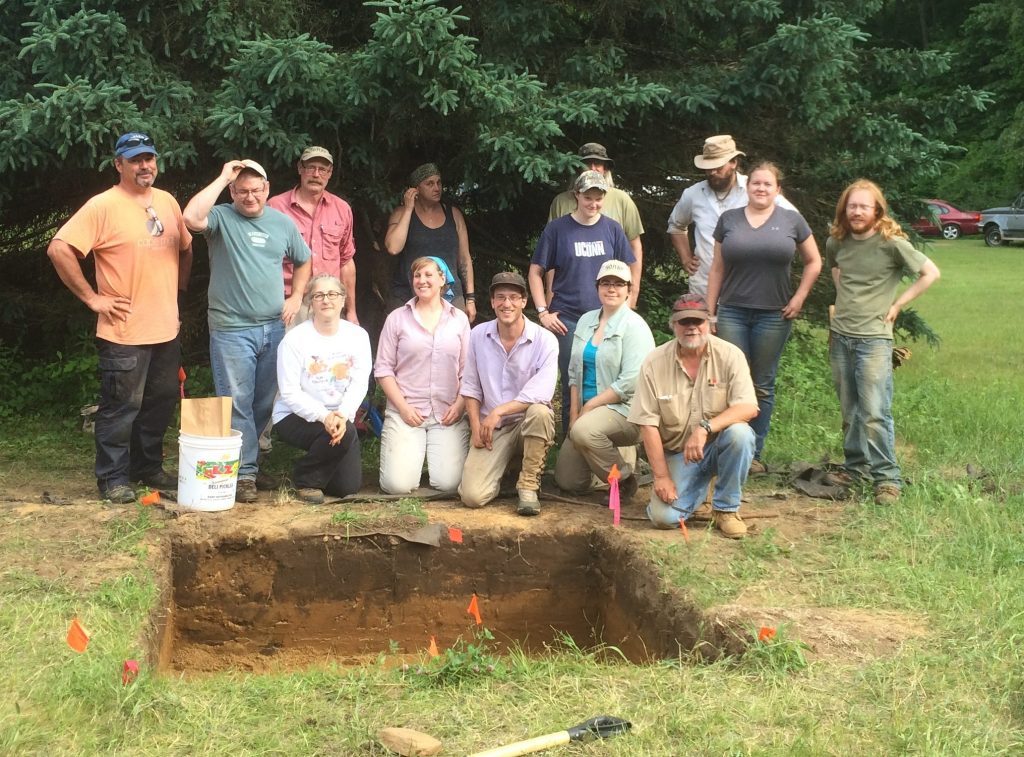
The crew stands in front of the 2x2 meter block where Zac Singer identified a new activity area at this 12,000 year old site in Washington Depot.
Excavation at the David Humphreys House, Ansonia
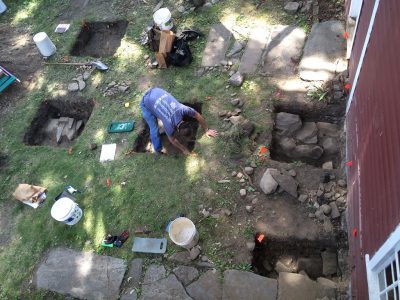
A rear-ell exposed behind during 2016 excavation of the David Humphreys House.
FOSA Newsletter Fall 2016
The Office of State Archaeology has had a busy and exciting few months since the last newsletter went out. A series of tremendous archaeological research opportunities kicked off with two weeks of work at the Templeton Site in Washington, Connecticut supervised by UConn graduate student and FOSA board member Zac Singer. After relocating Roger Moeller’s original excavation grid, control points were set across a large area of the site that had not been previously investigated. Shovel test pits were placed at four-meter intervals and excavated to depths in excess of a meter. Two, two-by-two meter excavation blocks were placed to better sample previously unidentified Paleoindian loci. One block produced additional abundant debitage, while the other was low in flakes, but did include a large probable Paleoindian flake tool and biface fragment. Zac will be busy with the interpretation of the new data for a while, but we look forward to his conclusions and recommendations for future work there. OSA was joined by many FOSA volunteers, as well as members of the Archaeological Society of Connecticut, the Institute for American Indian Studies, and the Litchfield Hills Archaeology Club. Professional archaeologists from AHS, Inc. and PAL, Inc., and even New Hampshire State Archaeologist Dr. Richard Boisvert joined in as well, while Dr. Moeller stopped by often and provided important insights. It was an extraordinary opportunity to reexamine one of the state’s most significant sites and I’d like to thank all of you who were able to lend a hand, job well done!
FOSA volunteers and four UConn graduate students also helped with the important rescue of materials from the off-campus Baker Building. Baker was a former storage space for OSA and records going back to Doug Jordan’s time had been kept there. The building had also been used as overflow storage for some very important archaeological collections. Because Baker has been mothballed by UConn, we had to secure the important documents and site assemblages in a new safe location. Some of the more notable collections recovered were from the Late Archaic Tinkham Site, the Terminal Archaic Schwartz Site, and the Late Woodland Morgan Site. I was recently contacted by UConn about some possible new off-campus storage space, so keep your fingers crossed and be prepared to come help with the move when the time comes!
In June, FOSA volunteers helped with a week of excavation at the National Register-listed David Humphreys House in Ansonia. The David Humphreys House is home to the Derby Historical Society. It was constructed in 1698 and is the birthplace of David Humphreys, aide-de-camp to George Washington during the American Revolution and the young nation’s first ambassador. Humphreys is also famous for importing the first Merino sheep from Spain which resulted in a transformation of Connecticut’s landscape as the new fine-fleeced flocks soon dotted the countryside. Work was conducted at the site because of proposed drainage improvements that threatened to disturb the buried archaeological record behind the house. The archaeological work conducted here by FOSA volunteers uncovered evidence of a forgotten rear lean-to, as well as the remnants of daily life between ca. 1700 and the 20th century. Among the most interesting finds were children’s toys, including clay marbles, a tin soldier, pencil leads, and an inch-long mid-19th century porcelain doll known as a “Frozen Charlotte.” Because of the significance of the site, FOSA members may have a chance to return for follow-up work this fall, so keep your ears open if you are interested.
Following that excavation, OSA ran its pilot Archaeological Field School for Educators. This program was developed to provide educators with a hands-on experience in archaeology so that they could share their enthusiasm for the past with their students. Work at the site focused on the examination of a filled house cellar in Windsor believed to be that of Captain John Mason. Mason is an historically controversial figure, famous for leading colonial militia in a bloody war against the Pequot tribe in 1636. The house was later occupied by the Marshall family who appear to have abandoned it in the second half of the 18th century, and most of the artifacts and food remains recovered appear to reflect their long use of the property. Some of the finds made here included German Westerwald stoneware, English scratch-blue stoneware, delftware and slip-decorated earthenware, all characteristic of the early to mid 18th century. The landowners and Windsor Historical Society have been very supportive of this research, so we hope to be back in future years with the same program. Special thanks go to FOSA members Lori Kessel and Scott Brady who acted as mentors to the teachers who took part in the program.
Last, but certainly not least, OSA ran the CT State Museum of Natural History’s adult field school at the Lt. John Hollister Site in Glastonbury in August. As mentioned in the last newsletter, we had high hopes that the site would prove to reflect an intact 17th century farming complex and we were not disappointed! Work at the site had previously kicked off with a spring-break magnetometry survey by University of Denver graduate students Maeve Herrick and Jasmine Saxon. This summer, Jasmine and Maeve returned for follow-up ground-penetrating radar studies that expanded on Peter Leach’s original survey last summer. This work will prove invaluable for future excavation planning and site interpretation moving forward.
The excavation season focused primarily on three of the four cellar features identified in the radar surveys. Portions of these cellar features were excavated to their floors at a depth of about 150cm. The cellar fill proved to have preserved very rich deposits of faunal remains, including both wild and domestic animals, as well as fish bone and scales and abundant shellfish. FOSA member Lori Kessel also identified maize and bean fragments during the excavation. The finds were too numerous to mention, but some highlights included a very uncommon fragment of a north Italian marbleized slipware bowl, numerous decorated delftware sherds, abundant red and white clay pipe fragments, a brass bell, a latten slip top spoon, examples of German stoneware and a variety of English slip-decorated and lead-glazed earthenwares. Of particular significance was the recovery of fragments of a very large Native-made storage vessel. This item is a tangible reflection of the close relationship between the Hollister family and the local Wangunk people suggested by some of the historical accounts of the period. FOSA volunteers provided tremendous help with two busy public dig days sponsored by the Historical Society of Glastonbury: one for the general public and one for two local scout troops working on their archaeology merit badges. FOSA volunteers completed the excavation season with some time to explore the site on their own and to wrap up all of the loose ends. Special thanks go to the Packard family for their generosity and permission to work at the site and interrupt their summer!
There will be plenty to do this fall for volunteers in the lab, so keep your eyes on the OSA Facebook page and FOSA web page for updates!
Citizen Science through the Office of State Archaeology
Frozen Charlotte
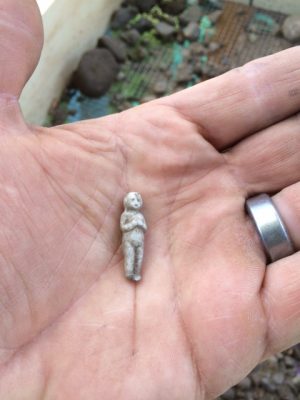
A mid-19th century "frozen Charlotte" penny doll from the David Humphreys House, Ansonia.
UConn Office of Public Engagement Newsletter Fall 2016
During the summer months of 2016, members of the public worked with the Office of State Archaeology at two historically significant sites: the Captain John Mason house site in Windsor, and the Lieutenant John Hollister farm in Glastonbury. A special one week field school program specifically for secondary school teachers was piloted this year at the John Mason house site. The program was developed to provide educators with a hands-on experience in archaeology so that they could share their enthusiasm for the past with their students in the classroom. Work at the site focused on the examination of a filled 1635 house cellar believed to be that of Captain John Mason. Mason is an historically controversial figure, famous for leading the colonial militia in a bloody war against the Pequot tribe in 1636. The house was afterwards occupied by the Marshall family through the 18th century, and most of the artifacts reflect their use of the property. One of the teachers produced a very engaging video of the excavation to share with his students. Imaginative independent projects such as that one have set a precedent and new standard for future field schools for educators planned for next year.
The Lt. John Hollister Site is a large farming complex dating between 1650 and ca. 1715. The site is unique both for its scale and degree of preservation and is arguably the most significant archaeological site in the state. Archaeological work conducted at the site in Glastonbury included a one week adult field school offered through the Connecticut State Museum of Natural History. Field school participants included college students, seniors, and working professionals, including a city planner. The Office of State Archaeology also supervised one day public excavation programs for the Historical Society of Glastonbury and two local scout troops. Work at the Hollister Site was wrapped up by volunteer members of the Friends of the Office of State Archaeology who helped supervise work at both locations.
While many archaeologists run “sand box” excavations for the public using artificially constructed sites, I believe that permitting the public to conduct authentic hands-on research is the best way to encourage a long-term interest and investment in the past. Ultimately, the goal of these programs is less about the artifacts and data recovered (though these can be very significant) than it is about instilling a preservation ethic in the public. Archaeologists, like other historic preservationists, are challenged daily with the loss of information about our shared past, usually because of the lack of knowledge of those making planning decisions. The hands-on experience provide by public outreach field schools in archaeology helps to bring the past alive in the most tangible of ways, developing a grass roots investment in the past that can have long-term repercussions for historic preservation.
News from the Office of State Archaeology
Windsor Meadows
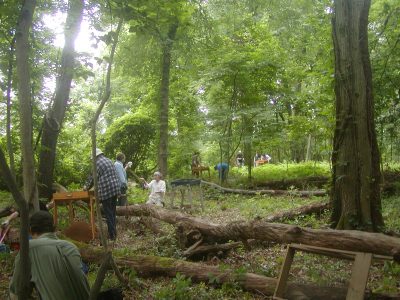
Looking for evidence of 17th century activity at the Windsor Meadows site.
Field crew
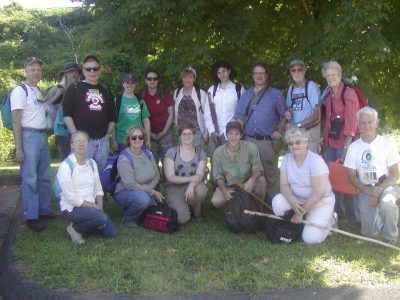
The hearty field crew team.
FOSA Newsletter Spring 2016
It has been a busy few months for FOSA volunteers at the Horsebarn Hill lab of the Office of State Archaeology. We have pushed our way through the prepping and cataloging of many of the office’s backlogged sites – some dating back many years. This hard work has resulted in a much better organized lab and I am extremely grateful to all of those who have helped out. One of the office’s major steps in the past few months was the re-establishment of the computer-based archaeological inventory system. The database had been in use in the early 2000s, but with the loss of some of the office’s graduate support staff, its use unfortunately faded from daily practice and for the past decade records went largely back to paper forms. I spent some time cleaning up the new (old) database to increase its ease of use and add some functionality. Now artifacts inventories, ID tags, and reports such as mean ceramic dates and mean pipestem dates are again available at the press of a button. Some FOSA members, such as Lori Kessel and Scott Brady have now had a chance to get to know the system, and are currently finalizing the inventory of the 2014 CSMNH Titus Coan field school site, while I continue to pick away at the inventory of the 2015 CSMNH Mason House lot field school site. I am pleased to say the inventory of the 2015 FOSA Windsor Meadows field school site was completed this Fall as our first test case of the new system.
We are making plans for this summer’s field schools, including one aimed at secondary school teachers interested in teaching archaeology to be held the week of July 18th. That will likely take place in Windsor, but the details are still being fleshed out. If you are a teacher, or know one, and want more information about this program, please contact David Colberg at the CSMNH (david.colberg@uconn.edu). The Natural History Museum’s adult field school will be held, as usual, during the first week of August (the 1st through 5th). This year we will be following up on last summer’s preliminary investigation of the John Hollister site in South Glastonbury, a 17th century fortified farm complex. The goal will be to explore the site’s four cellar features discovered during the GPR survey and establish their chronology. Those interested should also contact David Colberg at the museum. FOSA’s field school will take place at the same site from August 15th through 19th. Members are welcome to come and help us wrap up this season’s investigation for a day or the whole week, as space permits. By this time we should be well into all four cellars, and if all goes as anticipated, we should be examining some very interesting and uncommon 17th century artifacts and features. Stay tuned to the FOSA web page for further information.
In the meantime, FOSA members interested in volunteering for fieldwork should be sure they are on the contact list. I am expecting a number of Natural Resources Conservation Services digs beginning shortly this Spring. Also, anyone with experience in historical document research is welcome to lend a hand with our ongoing examination of the rich history of the families who occupied the John Hollister site between 1650 and about 1715, including the Gilberts and Hollisters. Preliminary investigation of the records at the Wethersfield and Glastonbury clerk’s offices, as well as the State Library indicate that there is a wealth of primary information available about these families, including records of numerous land transfers and disputes and other legal documents. My thanks go out already to Kris Keegan who provided the transcription of a particularly challenging probate document. Those interested should contact me to best coordinate our efforts.
News from the Office of State Archaeology
The Pope Mastodon
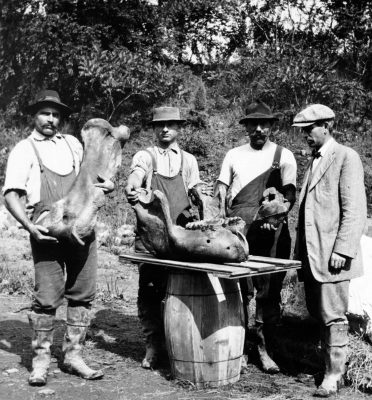
Workmen with their discovery at the Hill-Stead Estate, Farmington in 1913.
FOSA Newsletter Fall 2015
The students are all just back on campus as I write this, so I know that summer is sadly over. It has been a busy Spring/Summer season for OSA and the FOSA support team. I managed to finish the flotation of the many bags of soil from the features excavated last fall at the Dug Road site in Glastonbury. The charred material recovered from the features permitted the identification of plant remains by Tonya Largy. Tonya noted that the most common identifiable plant fragments were from butternut shells. Interestingly, carbonized bark made up between 40% and 95% of the botanical remains examined. Since then, Mike Raber and Marc Banks who have been working on the final site report have completed radiocarbon dating of five feature samples. These range in age from 4230 to 3880 radiocarbon years ago (ca. 2900 – 2300 calBC).
In May, FOSA volunteers helped to excavate around the north and east foundation edges of the Long Society Meeting House in Preston. This National Register site is in need of repair to the rotting sills, and we were able to help lower the surrounding ground surface safely, while avoiding possible impacts to nearby burials. In May and June FOSA members also helped out with a new Kids Dig for Bozrah Middle Schoolers. The community there was very supportive and I am hoping that this turns into another regular outreach program for us.
In June we began our investigation of a possible location of the Windsor Trading Post site with the help of Kevin McBride’s Pequot War Battlefield metal detector specialists. Their survey identified a brass point and a small brass ring, as well as a strike-a-light and lead shot that could also date to the first half of the 17th century. The FOSA Field School continued the investigation of the site through standard Phase II shovel test pit sampling. While we identified possible Middle Woodland activity at the site, no additional traces of the Contact period component were found, suggesting that this was a short-term Native American satellite camp occupied at about the same time that the Windsor Trading Post was in operation.
Working with the Glastonbury Historical Society, we only had two days to investigate the late 17th century Lt. John Hollister lot in South Glastonbury, but FOSA members and other supporters found evidence of a substantial farming complex that consisted of a long “cross passage” style house with three cellars and an additional possible barn and cellar nearby, as well as a number of well features. These incredible results are mostly the work of UConn graduate student Peter Leach’s GPR survey. This is truly one of the most significant sites I’ve had the privilege to work on in the state of Connecticut, and I look forward to working closely with the Glastonbury Historical Society and landowner Mark Packard at the site again next year.
The Connecticut State Museum of Natural History sponsored its own Kids Dig at the Farwell House and Barn site here on campus. Zac Singer and Lori Kessel organized and implemented the excavation with the help of other FOSA volunteers. The Natural History Museum’s Adult Field School took place at two nearby locations in Windsor this year. I have been waiting patiently for about ten years to look for evidence of the Pequot War-era Windsor palisade and finally had my chance. The remnants of the palisade proved elusive to both GPR and standard archaeological testing methods. The stratigraphy documented in the lot investigated along Palisado Avenue indicated that the land surface had unfortunately been significantly altered in the historic period, probably erasing any trace of the palisade trench. A separate GPR survey and excavation within the bounds of John Mason’s lot within the palisade did, however, uncover evidence of an undocumented filled cellar. Long forgotten to local memory, this late 17th to early 18th century house site contained an abundance of domestic artifacts including straight pins, buttons, coins, clay pipe fragments and ceramics, including English slipware, Rhenish and Westerwald German stoneware, porcelain, and English brown and white salt-glazed stoneware.
Finally, I want to especially thank FOSA this year for supporting the radiocarbon date of the Farmington Pope Mastodon (see article in this issue). The date represents very significant new data that helps us reconstruct the late Ice Age landscape of southern New England shortly before humans first arrived here. The Pope mastodon will be returning to an exhibit at the Institute for American Indian Studies this fall. “Old Longtooth” had previously been on display at the Institute between 1977 and 1989, and everyone should take the opportunity to see this old friend again.
News from the Office of State Archaeology
Merriman Cemetery, Southington
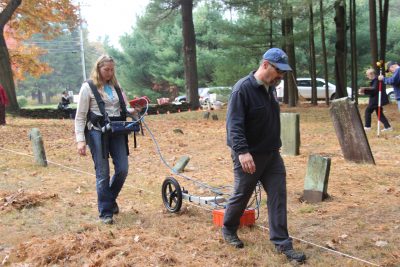
State Soil Scientist Debbie Surabian and FOSA meber Scott Brady conduct a GPR survey at the Merriman Cemetery in October, 2014.
CSMNH Newsletter Spring 2015
As an archaeologist working in Connecticut for over twenty years, I sometimes asked myself, I wonder what Nick Bellantoni does as the State Archaeologist? Well, since last July I’ve begun to find out. I expected that there would be calls and emails from the public about strange things found in their gardens. I expected that there would be days spent in meetings at the State Historic Preservation Office. I expected that there would be requests for archaeological assessments from developers. I expected that I would be giving plenty of public talks and would be working with school groups at local sites. But there were a number of things I didn’t expect.
The first became immediately apparent as Nick drove me around the state that first month to meet scores of individuals deeply committed to historic and environmental preservation. Getting to know and work with these people has been one of the real pleasures of the job. I also learned that I belong to a National Association of State Archaeologists that refers to itself as NASA. While we aren’t astronauts, the group maintains a stellar email-based information exchange system that provides instant access to very knowledgeable individuals who deal with the same types of issues across the country.
Perhaps the biggest surprise I had starting the job was the public’s interest in cemeteries. Cemeteries are clearly central to people’s sense of heritage and place, but at first I simply did not understand what they had to do with archaeology. It turns out that Connecticut has a lot of cemeteries, and many of them are small and long forgotten. When Charles Hale completed his index of the state’s cemeteries in 1937 he had identified 2,269 burial grounds, or an average of over 13 per town. Today many of these family cemeteries are threatened by neglect, and sometimes construction. Luckily, I’ve met with a number of people committed to better managing and protecting them. In the past year I’ve already worked on eight of the state’s cemeteries, from Darien to Woodstock, and I expect this will continue to be an important, if unanticipated, aspect of the job.
News from the Office of State Archaeology
Dug Road Site
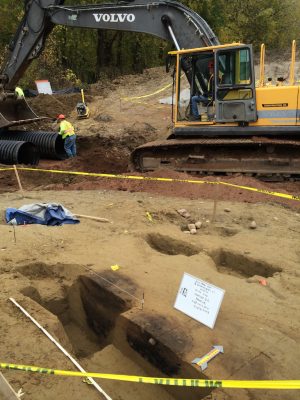
4500 year old cooking features exposed during construction.
FOSA Newsletter Spring 2015
September already feels like a millennium ago – I guess I’ve been busy! First, let me start off with some of the big-picture items. In the Fall and Spring semesters, FOSA supported an intern, UConn student Melissa Shongut, to help with the organization of the Norris Bull Collection. This semester, the Department of Anthropology also provided research assistantship funding for Zac Singer to work with us as well. For those of you who don’t know it, the Bull Collection is the Office’s core collection of artifacts gathered during the early and mid-twentieth century from across the state by Norris Bull. Acquired in 1960, the need for adequate care of the collection was largely responsible for the hire of Douglas Jordan in 1963. Dr. Jordan was UConn’s first archaeologist and Connecticut’s first de facto State Archaeologist. The Bull collection is a remarkable tribute to Native American craftsmanship across the state. While many of the artifacts are on display at UConn and on loan to other institutions, one day more of this collection must be made available to the public, as it was originally intended by Bull himself. To help OSA further manage this collection, the Department of Anthropology has approved a new internship course in collections management. This course should appear in the catalog next Fall and it is hoped that five or six students will enroll each semester.
In terms of fieldwork, it was a busy time as well. FOSA volunteers helped with a number of Natural Resources Conservation Services projects in towns across the state, including Guilford, Woodstock, and Southbury. FOSA members also provided necessary support for youth excavation programs at the Horton Farm in South Glastonbury and at the very significant Lewis Walpole Site in Farmington, organized by our own Jeremy Pilver. FOSA members also helped Dr. Bellantoni wrap up his investigation of St. Platon’s Church in Danbury. One of the more interesting emergencies I had was a call to a small coffin discovered during waterline work on Farmington Avenue in Hartford. Scott Brady was able to assist in what, luckily, turned out to be a very elaborate dog burial, probably dating back to the eighties. Included inside the padded coffin, lined with white fabric, was a plastic cross, a rosary and two laminated prayer cards. The excavation work was overseen by a representative from the major crimes unit and what appeared to be most of Hartford’s detectives.
That field work was quickly overshadowed by rescue excavation in South Glastonbury, where a large drainage pipe construction inadvertently uncovered a number of Native American cooking hearths and a fire-cracked rock pavement – possibly a portion of a house floor. FOSA members Scott Brady, Lee West, Jerry Cavanaugh, Mike Grant, Brian Meyer, Ed Goodrich, and Glenda Rose volunteered numerous hours at the site. The deep cooking features (or “earth ovens”) were rich in charcoal, but lacked associated artifacts. The fire-cracked rock pavement produced a number of Late Archaic Narrow-Stem points as well as an uncommon paint pot still stained with ocher. One of the cooking features was recently dated to 4230+/-30 radiocarbon years ago, or about 4,800 actual (calibrated) years ago. Negotiations between OSA, the State Historic Preservation Office and the Town of Glastonbury resulted in an agreement to fund the analysis of the site, as well as additional testing closer to Tryon Street. FOSA member Mike Raber was later awarded the contract to do this work. His work includes a budget for additional radiocarbon dating and identification of plant remains from the features. I expect that the rich charcoal samples will provide a better picture of the types of local plants used in the diet by these early inhabitants of Glastonbury.
To wrap up the season, Dr. Douglas Owsley of the Smithsonian spent two full days on campus evaluating human skeletal remains from the William S. Laughlin collection. During his visit, he was helped by UConn students and members of FOSA. Dr. Laughlin was a physical anthropologist at UConn between 1969 and 1999. The materials were brought to OSA by family members so that they could be appropriately repatriated. That work is ongoing.
Helpful Aurora Guides for New Webmasters
To get started on your new site, take a look on the Aurora site for tips on how to get started.
New Site Launched
We are proud to announce the launch of our new Office of State Archaeology website. Built on the the university Aurora service, this new version of our site sports a modern look, faster loading times, and works on all mobile and tablet devices.

